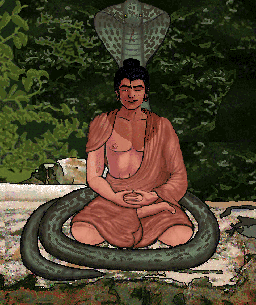©
Nanabozho (Gichi Wabush)
This page updated 15 December 2006
Home Growing
up a Lotus Master
Gudo Papers Teachings Pali
Canon
Mahayana Sutras Humour History Gallery Contact Links
|
©
Nanabozho (Gichi Wabush) |
|

The Practice of Zazen
Introduction: my personal approach
Limbering up exercices: the sun salutations
Growing a lotus: or how not to damage one's knees
Sitting
Siddhartha Gautama, after he left home, dedicated himself for a few years to the most extreme asceticism, while he studied the most important philosophical doctrines of his days. None did fully satisfy him, and as for asceticism, it almost brought him straight to death by starving.
One legend says that, totally emaciated, gaunt and all bones, and relentless like the most relentless of saddhus, he heard a musician explaining to his pupil, "You see, if you don't tighten it taut enough, the string won't speak. But if you tighten it too much, it'll snap."
This phrase has for me a very exact meaning, almost physical. When I'm tuning a harpsichord, and a string snaps, for they are often tightened up to almost their breaking point, since this is where they sound best, when that happens, I always get a feeling that borders on horror...
At that moment, then, Siddhartha decided not to snap, and left his mortifications. There, he sat and understood. After that, and until the end of his days, he sat and recommended sitting.
Every teacher has recommended sitting, for tens of centuries, with the Lotus Posture as being best for the practice of Zazen.
Indeed, it allows for keeping the spine straight, from coccyx to skull, the spine taking on that S shape which can be seen depiected in every book of anatomy. Sitting thus makes for a calm and natural breathing, and time lapses without one getting to sleep or loosing his/her nerves.
Eric Rommeluère mentions a small book entitled Zen Buddhist English Sutraspublished in 1948 by the Hawaii Soto Mission Association, where, in the section dedicated to explanations about Zazen, which was first written in Japanese by Reverend Kurebayashi, Professor of Buddhism at Komazawa Buddhist University, and distributed by the administration of the Soto Zen Sect (which means it was not primarily meant for Westerners), one may read those lines : "In every book about Zen, a passage may be read : `Zazen is an easy and comfortable practice of the Buddha-dharma.' [after Master Dogen's Fukanzazengi] One ought not take it up in such manner that it induce physical pain. If it were to be done in force, by enduring the pain, it could never be an easy practice, but on the contrary, some sort of self-mortification."
Such an
assertion is
likely to perplex those who have an altogether different experience. A
discussion between teachers of the American Zen Teachers Association on
their forum and published in the 2002 Summer number of Prairie Wind
Magazine shows that such discoveries are at times unsettling. Please
check this paper on
the subject. The
logical conclusion is that we ought to limber up in order to make this
possible. Various methods are available, and may be combined according
to circumstances.
Zazen is an "asâna", a yoga posture. Za means sitting, but also meeting. Zen is from the Sanskrit Dhyâna which means contemplation. It is the essential practice of Zen Buddhism, for it is through it that the "Zennist" tries to actualize the teachings, in a practice of Unification with the Universe.
If you're being taught a technique, whatever it may be, you may learn it in a classroom, or in a workshop. If you only learn it in a workshop, you'll have problems when it'll come to actualising it's practice, naturally, without effort. If you only learn it on the job, you might end up being unable to transcend simple ordinary practice. The Middle Way, once more, allows you to marry both. You learn theory, put it into practice, and if your practice is not efficient, it's either the theory which is bad, or -- which is more often -- you didn't understand it correctly, and/or integrated it faultily.
Our practice in Buddhism is therefore sitting. There are only two or three correct ways of sitting, and all consist in sitting on the ground, cross-legged, with a straight spine. Differences are; either you cross you legs in a lotus, either in half a lotus, either in the so-called "Burmese" posture. But, in every case, those are difficult for bodies accustomed to chairs.